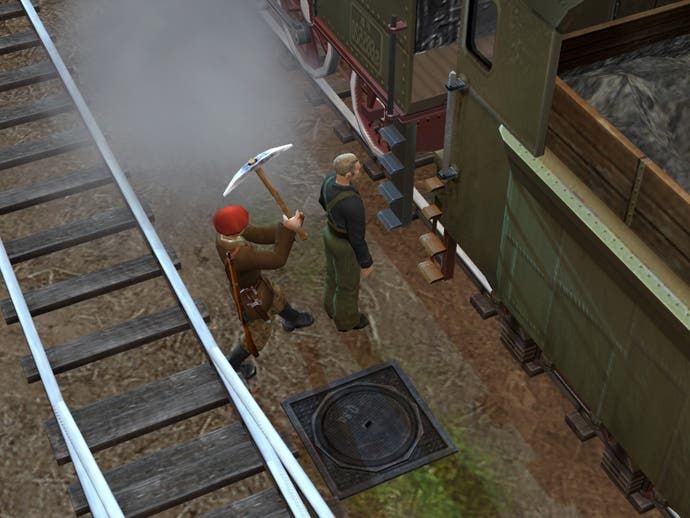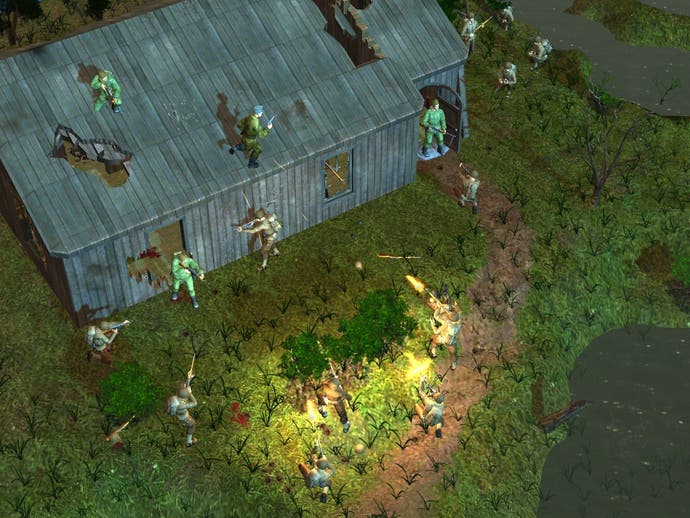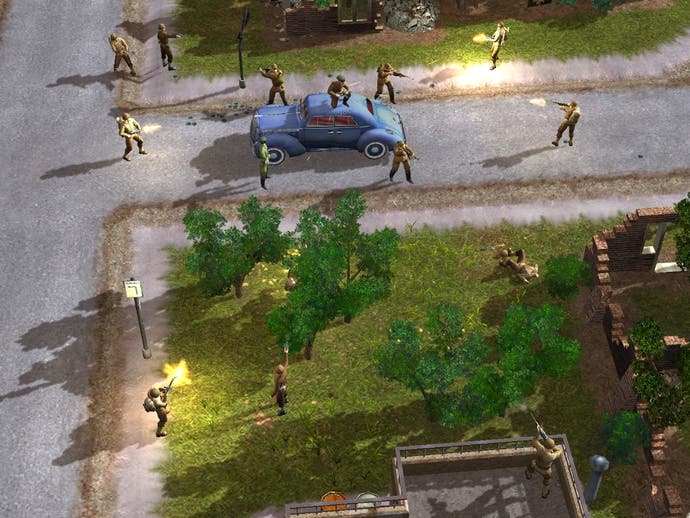Hammer & Sickle
Russians with more front than Blackpool.
Excerpt from the Diary of a Russian Spy. April 1949.
Tuesday: Day off. Went down the Hammer & Sickle, early doors. Spent the afternoon queuing for a pint. Spent the evening drinking said pint (it was a pint of vodka). Rolled back to the barracks late, merry and in the mood for an army-style prank. Tied some booby-trapped grenades onto the back of the commander's jeep and stuck a sign on the bumper: 'Just Maimed'.
Wednesday: Inexplicably ordered off on a perilous mission behind enemy lines in Allied occupied Germany. Commander actually used the word 'expendable'. Bugger.
Expendable is about right, because Nival's tactical combat RPG is plain brutal, ticking the challenge box with an extra-thick black marker pen. The trouble is, it also promises the grand framework of a sprawling open-ended world, replete with Cold War intrigue and spying, character recruitment and role-playing elements. But it can't seem to find as much as an HB pencil to check those boxes.

The basic game mechanics are solid enough. Normal movement happens in real-time, switching to a turn-based mode during combat, in which each character has a pool of action points to spend. Jagged Alliance players will find this comfortingly familiar, as will X-Com veterans, although they'll probably be surprised by the brutality of the first firefight.
Once across the border, your character faces a battle against an unknown enemy militia. The computer AI plays a decent tactical game and often greatly outnumbers the player (in this case by ten troops to one). It's plain nasty on medium difficulty, as in-mission saves aren't allowed, so you're advised to select easy (a misnomer in itself) and save frequently.
Overall, combat is a pleasing mix of strategic decisions and explosion candy. A sniper can command the battlefield from a second storey window, aiming for head-shots, or even arm-shots which cause guns to be dropped. Almost one hundred authentic weapons have been modelled and there's a considerable thrill in ripping huge holes in a wall with a machine-gun, or blowing out an entire window frame with a grenade.

While the environments are competently rendered, there's no excuse for the jerky scrolling which afflicts the more detailed levels, or the stilted character animation. Battles are also marred by lengthy pauses while the computer processes its turn, and assorted interface bugs (sometimes the game will randomly decide that you can't drag-select your group, or that a perfectly good move is a "path not found").
After the initial baptism of gunfire, you're free to roam the campaign map, seeking out recruits, flogging salvaged weapons and chatting to locals for clues as to the next sortie. It sounds great, but it isn't. There are very few locations to visit on the map, and new ones are revealed in a linear fashion, as are the plot-driving missions and potential party members. Conversations are one-dimensional and the NPCs wooden, with little scope for exercising stealth or diplomacy. The entire role-playing side is rather thin, with character development being limited to selecting special abilities (skills and attributes are usage and experience based).
So, the freeform exploration turns out to be largely on rails, and the theatre of operations is claustrophobically small, a theme carried over into the game's levels. The local town consists of a pub, shop and police station - it's an idiot short of a village, let alone a city. Yet despite these confines, it's still possible to wander through Hammer & Sickle feeling rather lost.

The central plot events are patchily related and the clichéd storyline is relayed via poor cut-scenes and journal entries written in bad English. There's little direction given and half the time you're left meandering around hoping to bump into the next plot fragment.
A lack of decent mission briefings also adds to the confusion. Let's talk about the Wenzburg scenario - this features a battle against some terrorists, which I duly won, then ran into difficulties attempting to exit the level. Nearby US troops would show up and annihilate me in a cut-scene, no matter what I did. I reasoned that I had to eliminate the American presence from the area entirely, which involved a massive scrap with many enemy reinforcements and much saving and reloading. Nevertheless, my party prevailed and when I exited... some yanks appeared and shot me. ARGH.
It turns out you're not supposed to leave this way, hence the compulsory dying. I'd missed the alternate exit, tucked away in a basement trench, which was my own stupid fault. But that daft cut-scene, incorporated for colour, had me barking up the wrong tree with a pointless two-hour anti-American crusade. Why didn't Nival simply remove the unusable exit, or make the cut-scene's intention clearer, or God forbid, actually provide a proper mission briefing with a hint?
Eventually, the mire of frustrations, constant reloading, harsh difficulty level, bugs and generally poor design wears you down. Rabid strategists will appreciate the game's saving grace, the combat system, and may find themselves more tolerant. Good luck to them. They'll need it.







